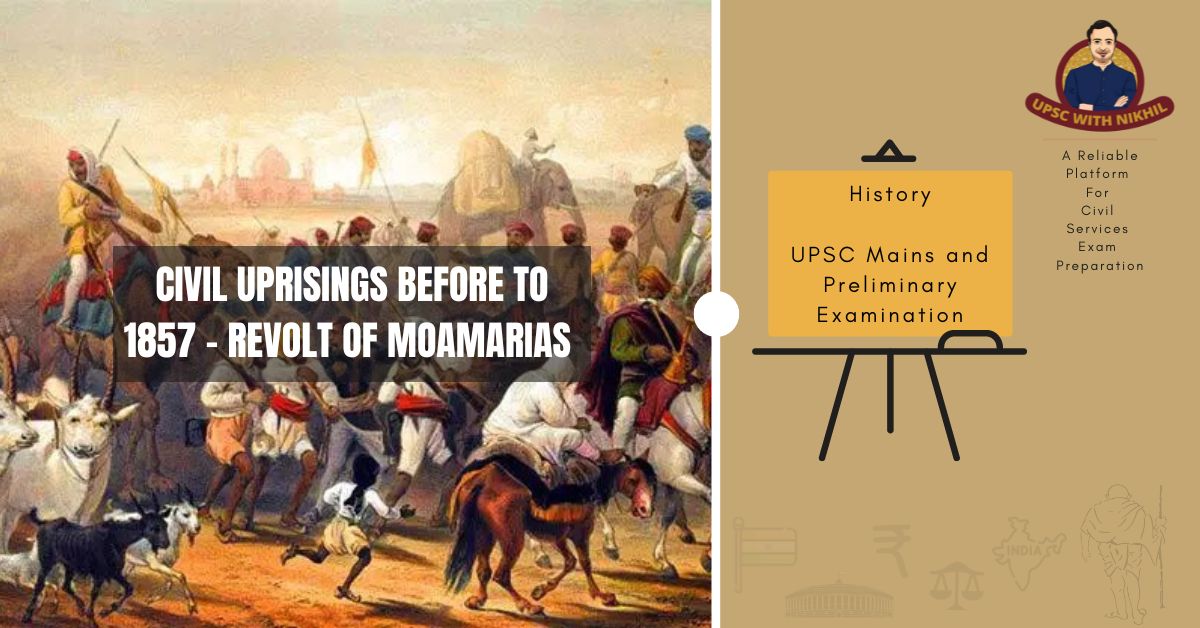Civil Uprisings Before To 1857 - Revolt Of Moamarias
Introduction
The Moamaria uprising of 1769 posed a significant threat to the Ahom kings of Assam. In the 18th century, in the Ahom kingdom of modern-day Assam, a power struggle between the Moamarias (Matkas), followers of the Moamara Sattra, and the Ahom kings gave rise to the Moamoria revolt. The Ahom monarch lost control of the capital as a result of this war that spread throughout the Ahom kingdom and involved disillusioned members of the Ahom aristocracy.
Background of The Moamarias Revolt
• The insurrection against the Ahom Empire was headed by the Moamoria Paiks.
• The Ahom militia's main faction, the Morans, made up the majority of the Moamarias, along with other professional castes like the Horas (potters), Tantis (weavers), Kaibartas (fishermen), Bania (artisans), Sonowal Kacharis (gold-washers), and Chutias (expert archers and matchlock men). Ahom nobles and officers also belonged to this group.
• The Shakti cult, which had supported the Ahom kings, as well as traditional Hindu institutions had lost strength as a result of Moamaria Sattra's growing popularity.
• Anybody attempting to escape the Paik system, which let any physically capable individual who was not a Brahmin or a noble to be exploited for labor, services, or enlisted into the army, found refuge in the sattras.
• The Paik system, upon which the state was built, was unable to adapt to the changing economy and growing social layers, which put the Ahom kingdom in peril.
• One of the factors contributing to the Paik system's labor shortage was the expansion of the sattras, which led to the Ahom monarchy and the sattras' escalating conflict.
Moamarias Uprising
• Following Aniruddhadeva's (1553-1624) teachings, the Moamarias were low-caste peasants whose development mirrored that of other low-caste communities in North India.
• The insurrection began in 1769 CE when royal officers humiliated and chastised the Moamoria Guru and notable Moran disciples.
• There was already a great deal of anger from years of religious oppression, and the whipping incident only fueled it more.
• The King was put in jail after the Ahom troops were routed. The orgy of vengeance resulted in the execution of high-ranking officials and clergymen and the establishment of a puppet monarchy.
• Due to the carnage and the rebels' lack of experience managing a state, this government quickly came to an end.
• Following the rebels through the mountains and woodlands, the Ahoms collected their soldiers.
• In the protracted military conflict that lasted a year, the Moamorias lost their Guru, a number of their commanders, and hundreds of people.
• The subsequent guerilla conflict, which ranged from 1770 to 1788, increasingly depleted the resources of both factions.
• Regular military operations and guerrilla attacks took place. In 1788, a Moamoria expedition once more took Rangpur.
• In search of protection, King Gaurinath Sinha travelled to nearby nations.
• The rebel dominion had grown to such size by 1792 that the King asked the East India Company for help.
• Their uprisings rendered the Ahoms vulnerable and opened the area up to invasion by others.
• For instance, in 1792, a group of burkandazes (demobilized soldiers from Muslim armies and zamindars) assisted the King of Darrang (Krishnanarayan) in his rebellion.
• The Ahom ruler needed British support to put an end to these uprisings. At Bhatiapar, the Moamarias built their main base of operations.
• The hardest-hit areas were in Rangpur and Jorhat. The weakened kingdom, though it survived the insurrection and subsequently came under British rule, was overthrown by a Burmese invasion.
Ahom Dynasty
• The Ahom dynasty (1228-1826) ruled the Ahom kingdom in modern-day Assam, India, for more than 598 years.
• The dynasty was started by Sukaphaa or Tsue-Ka-Pha, a Shan ruler from Mong Mao who travelled through the Patkai Mountains before arriving in Assam.
• In foreign mediaeval chronicles, the rulers of this dynasty were referred to as Asam Raja, while among their subjects, they were known as Chaopha or Swargadeo.
• Under Suhungmung, it developed a multiethnic nature in the 16th century, greatly influencing the political and social life of the entire Brahmaputra valley.
• The kingdom's strength declined once the Moamoria uprising started, and Burmese forces frequently invaded Assam.
• This dynasty's rule came to an end with the Burmese invasion of Assam in 1826 and the subsequent annexation by the British East India Company under the terms of the Treaty of Yandabo.
• The East India Company took over the nation after the Burmese were defeated in the First Anglo-Burmese War and the Treaty of Yandabo in 1826.
Conclusion
Assam was unique in this way since other Indian kingdoms were weakened by succession issues or small-scale disputes with neighbors and were therefore prime targets for invasion. The Moamoria Rebellion, a protracted 36-year civil war that left Assam significantly weaker than it had been before the Burmese arrived and dealt the decisive blow.


